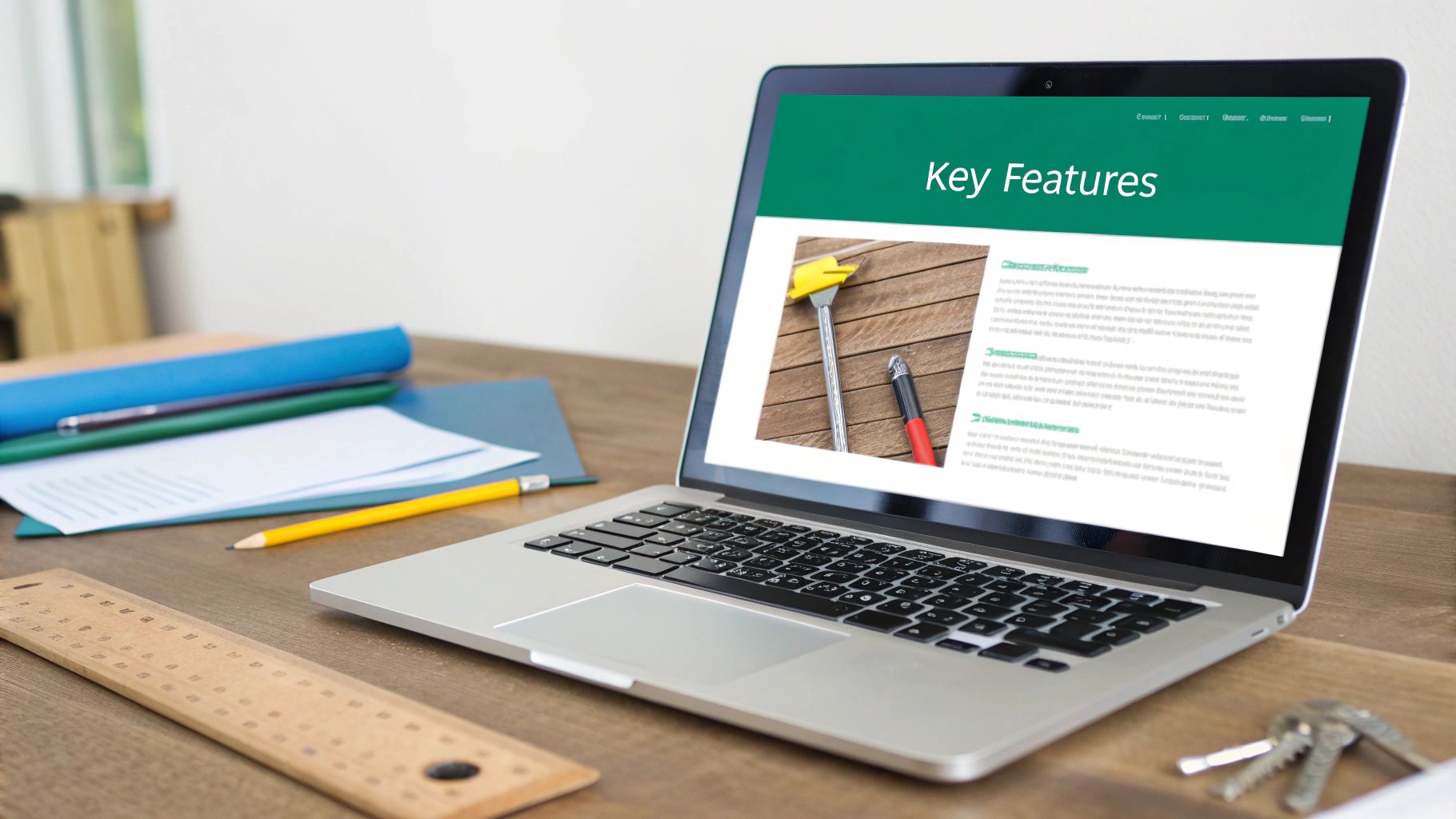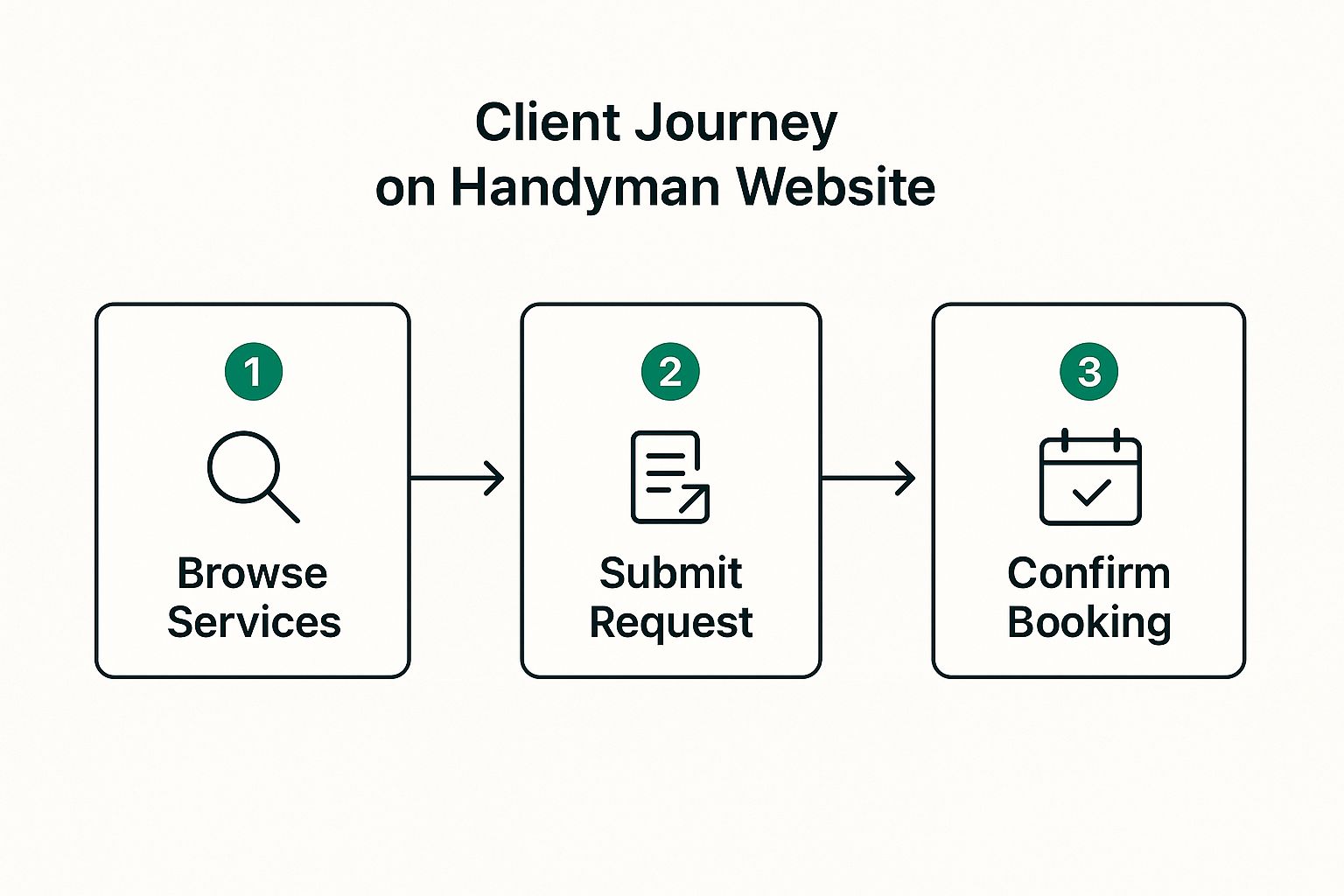Create a Winning Website for Handyman Services Today
Discover how a professional website for handyman can help you attract more clients and grow your business. Get started today!
Thinking about getting a website for your handyman business? It's no longer just a nice-to-have. It’s the single most powerful tool you have for landing more jobs in your local area. A good website works for you 24/7, building trust and pulling in local leads while you're out on the tools.
Why Your Website is Your Best Business Partner

Forget the old view of a website as just a digital business card. For a local handyman, your website is your hardest-working employee. Think of it as your virtual shopfront, open around the clock for potential customers in your suburb searching for the exact skills you offer.
Put yourself in a potential customer's shoes for a second. A homeowner has a list of odd jobs that need doing. They grab their phone and search "handyman in [Your Suburb]". They find two options. One is a basic Facebook page with a few grainy photos. The other is a clean, professional website that clearly lists your services, showcases sharp photos of past jobs, and has a big, easy-to-find "Call Now" button.
Who gets the call? It’s a no-brainer.
A great website does more than just list what you do. It instantly builds the trust a customer needs to feel comfortable inviting you into their home. It shows you're a professional and reliable local business before you've even had a chance to say hello.
That's what having your own online space gives you. You get full control over your brand and your message. You’re not just borrowing space on a social media platform that can change its rules at any time, potentially hurting your business.
Tapping Into a Booming Market
More and more, the search for skills like yours is happening online. The on-demand home services market here in Australia is exploding. It was recently valued at around AUD 183.09 million and is projected to grow at a massive 18.3% each year through to 2034. That growth comes from homeowners using their phones to find and book local tradies instantly. You can read up on this industry growth yourself.
Having a proper website for your handyman business puts you right in the path of this wave of digital-first customers. It makes sure you show up where people in your area are actually looking, turning those online searches into a calendar full of paying jobs.
It's Not Just About Getting Bookings
Beyond generating leads, a solid handyman website gives your small business a few other massive advantages:
- Show Off Your Craft: A gallery of before-and-after photos is undeniable proof of your quality work. It’s far more powerful than a messy social media feed for showing local customers what you can do.
- Build Your Authority: You can answer common customer questions in a blog or FAQ section, proving you know your stuff and positioning yourself as the go-to local expert.
- Save Yourself Time: A simple quote request form or a clear FAQ page can filter out tyre-kickers and answer basic questions for you, meaning fewer repetitive phone calls and more time on the job.
At the end of the day, an investment in your website is a direct investment in the stability and future growth of your local business.
Setting Up Your Online Foundation
Before you dive into picking out colours and fonts, we need to pour a solid slab. Just like with any good build, a strong foundation is what makes sure your handyman website can actually do its job: bringing you more of the right kinds of local work. This isn't about getting tangled in tech speak; it’s about making a few smart calls right now that will pay off for your small business.
First things first, you need a domain name. This is your address on the internet, like baysidepropertymaintenance.com.au. A good domain is easy for local customers to remember, simple to say over the phone, and ideally includes your business name. If you can naturally work in your city or main service (e.g., sydneyhandymanpro.com.au), that can give you a small boost in local search results.
Next up is web hosting. Think of this as the block of land your website is built on. It’s a service that stores all your site's files and makes sure people can see it when they type in your domain. For a local tradie, picking a reliable Australian web host is a smart move. It means your site will load faster for customers in your area, and a fast site is one people stick around on.
Who Are You Actually Talking To?
This is probably the most critical part of setting up your online presence. Who is your ideal customer? If you try to build a website for everyone, you’ll end up connecting with no one. You need to get specific. This clarity will shape every single word, photo, and button on your site to attract the exact kind of jobs you want in your service area.
So, who are you after?
- Busy suburban families who just need a reliable go-to for all the odd jobs and home repairs they don't have time for?
- Real estate agents who need someone professional and fast for pre-sale tidy-ups and rental property maintenance?
- Local businesses looking for someone dependable to handle ongoing maintenance contracts for their offices or shops?
Knowing your target customer is everything. It influences how you describe your services, the project photos you feature, and the overall feel of your site. A website designed to win over real estate agents will look and sound different to one aimed at young families—and that's exactly how it should be.
Once you know who you're targeting, you can map out a clear path for them. This graphic breaks down the simple journey a potential client should take on an effective handyman website.

The main takeaway here? Keep it simple. Your website’s only job is to guide a potential customer from checking out your services to booking a job in as few clicks as possible. Make it easy for them to give you work.
With your domain sorted, hosting in place, and a clear picture of your ideal local customer, you’re finally ready to choose a platform to build on. There are plenty of great options out there, and it's worth exploring the top website builders for small business to see what fits your technical skills and budget. Getting this foundational work right sets the stage for a website that doesn’t just sit there looking pretty—it actively goes out and gets you business.
Designing a Site That Turns Visitors Into Leads
 Let's be honest, a good-looking website is nice, but for a local handyman, it needs to do one thing exceptionally well: turn a casual browser into a paying customer. It’s a workhorse, not a show pony.
Let's be honest, a good-looking website is nice, but for a local handyman, it needs to do one thing exceptionally well: turn a casual browser into a paying customer. It’s a workhorse, not a show pony.
This isn’t about flashy animations. It’s about structuring your site with a few essential pages that work together to build trust with local homeowners, show off your skills, and make it ridiculously easy for people to book you for a job. Each page has a role to play in winning over your next client.
Think of your website as your best salesperson, working 24/7. It needs to anticipate a potential customer's questions and answer them before they even have to ask.
The Homepage: Your First Impression
Your homepage is your digital front door. You have seconds to convince a local visitor they’re in the right place. It must instantly tell them who you are, what you do, and the suburbs you service. No fluff.
A solid handyman homepage absolutely must have:
- A clear, benefit-focused headline. Something like, "Reliable Handyman Services for Perth Homeowners."
- Your business phone number, right at the top where no one can miss it. Don't make people dig for it.
- A high-quality photo of you or your van. Seeing a real person or a professional setup builds instant trust.
This is your first, best chance to show visitors they've found a professional local business. Get it right, and they will keep exploring your site.
The Services Page: Selling Solutions, Not Tasks
This is where you get down to the nitty-gritty of what you can do for local clients. My advice? Avoid just listing tasks like "deck repairs" or "plastering." Frame them as solutions to your customer’s problems.
For example, instead of just "Gutter Cleaning," try "Protect Your Home with Professional Gutter Cleaning." That small shift speaks directly to a homeowner's fears about water damage. Get specific and list all the services you offer, because people search for very specific things.
Actionable Tip: Group your services into logical categories. Think 'Repairs & Maintenance,' 'Carpentry & Assembly,' and 'Painting & Plastering.' This helps potential customers quickly scan your offerings and find what they need without getting overwhelmed.
Building Trust With Your 'About' and 'Portfolio' Pages
At the end of the day, people hire people they know, like, and trust. Your 'About Us' page is your opportunity to build that connection. Share a bit of your story – why you started your local business, that you live in the area, what you value. And yes, a friendly photo of yourself here is non-negotiable.
Then, you back it up with your Portfolio or Gallery page. This is your proof. It's where you show off your best work with high-quality before-and-after photos. This visual evidence is often the final piece of the puzzle that convinces a local homeowner to pick up the phone. Whatever you do, don't use stock photos here; they scream 'fake' and will kill your credibility.
The tradesman and handyman industry in Australia is a big one, with a market size expected to hit around $1.3 billion by 2025. With that much competition, a professional website that shows off your personality and real results is what will make you the standout local choice. You can discover more about the stable growth in handyman services to see just how vital a strong online presence has become.
Lastly, make your contact page dead simple. Include your phone number, email, and a basic contact form. Making it easy for a local customer to get in touch is the final, crucial step in turning that visitor into your next job.
Features That Will Actually Get Your Phone Ringing
A basic website is a decent start, but you're not in business to have a pretty online brochure. You need a website that works as hard as you do, turning local browsers into paying customers while you’re out on the tools.
It’s all about making it dead simple for someone to take that next step. Every feature on your website should be geared towards answering their questions, building their trust, and getting them to contact you—not your competition.
Make Getting a Quote a No-Brainer
One of the first things a potential local client thinks is, "What's this going to cost?" This is where a straightforward 'Request a Quote' form becomes your best tool. But there's a trick to it: get the info you need without making them feel like they're filling out a tax return.
Keep your quote form short and sweet. All you really need to begin with is:
- Name and Phone Number: So you can actually talk to them.
- Suburb or Postcode: Lets you instantly see if they're in your service area.
- Brief Job Description: Just enough to get the gist of what they need.
- Photo Upload Option (Actionable Tip!): This is pure gold. A quick snap of a busted fence or a dodgy light fitting gives you more insight than a ten-minute phone call ever could, saving you time.
Don't ask for their life story. Keep it simple, and you'll find far more potential customers actually hit 'send'.
Let Customers Book You Online
Think about it—many of your local customers are busy people who hate playing phone tag. Giving them the power to book a time with you directly through an online calendar can be a massive win for your small business.
This doesn't have to mean they lock in the job then and there. You can set it up so they can book a 15-minute chat on the phone or an appointment for an in-person quote. It gives them a feeling of progress and gets them committed to your business before they even think about ringing someone else.
This shift towards self-service is becoming standard practice for local businesses. The handyman software market in our region (Asia-Pacific) was valued at around $493.5 million and is expected to hit $703.4 million by 2025. This growth shows just how crucial modern scheduling tools are becoming. If you want to dive deeper, you can learn more about this industry trend and see how technology is changing the game for tradies.
Build Instant Trust with Customer Reviews
Word-of-mouth has always been the lifeblood of any good local tradie, and online testimonials are just the digital version of that. Dotting genuine reviews from past clients across your site—especially on the homepage and your services pages—is one of the fastest ways to show you’re the real deal.
Once you've finished a job and the customer is happy, just ask them! "Would you mind leaving a quick review on my site or Google profile?" Most people are happy to help when they've received great service. Adding their name and suburb ("Sarah M., Newtown") makes it feel authentic and relatable to other potential local customers. These little snippets of praise are your best salespeople.
Finally, a quick but crucial point: make sure your entire website is mobile-friendly. Most of your customers will find you on their phone, probably while standing right in front of the problem they need you to fix. If your site is hard to use on their mobile, they’ll be gone in a heartbeat. A clean, easy-to-use mobile experience is absolutely essential for a local business.
Attracting Local Customers on Google

So, you’ve got a slick new website. That’s a massive step, but it won’t fill your calendar with jobs if local customers can't find it. Think about it: when a homeowner's tap starts leaking, they aren’t reaching for the Yellow Pages. They’re grabbing their phone and searching on Google.
This is exactly where your small business needs to be seen.
We’re going to cut through the jargon and get straight to what matters for getting your local business found online. This isn't about becoming a tech wizard; it’s about making a few smart moves to show Google what you do and where you do it, so you pop up when locals need you most.
The Most Important Free Tool for Your Business
If you only do one thing to get found on Google, make it this: set up and properly optimise your Google Business Profile (GBP). This free tool is the engine behind the map listings and business info you see right at the top of local search results.
It's the digital equivalent of having the best shopfront on the busiest street in town. When someone searches for "handyman near me," a well-managed GBP gives you a prime shot at being one of the first names they see, complete with your phone number, reviews, and a direct link to your website.
Think of it this way: your website is your workshop, but your Google Business Profile is the giant, flashing sign on the main road pointing everyone to it. Ignoring your GBP is like having a great business but keeping the roller door shut.
Actionable Step: To make your GBP work for you, fill out every single section. Add your specific services, your opening hours, high-quality photos of your work, and—most importantly—your exact service areas (the suburbs you work in). Google uses all this information to match you with customers in your neighbourhood.
Speaking Your Customer's Language
Next, you've got to think like a local customer. When they've got a problem, what words do they actually type into Google? It's rarely just "handyman." They search for solutions to specific problems.
This is the whole idea behind finding good local keywords. Your job is to weave these phrases naturally into your website's content, especially on your homepage and service pages.
Here’s a practical example for your local business:
- Instead of "Handyman," try "Reliable handyman services in Wollongong."
- Instead of "Decking," use "Deck repair and maintenance specialist in the Inner West."
- Instead of "Plastering," target "Plaster wall patching in the Sutherland Shire."
See the difference? These locally-focused phrases attract customers who are ready to hire someone for the exact work you do, in the areas you service. By using the same language as your potential clients, you're telling Google loud and clear that you're the right local tradie for the job.
If you’re serious about getting your business on the map (literally), check out this in-depth guide on how to get my business on Google Maps. It’s a full walkthrough that shows you exactly what to do. Combining a well-built website with a strong Google Business Profile is the best strategy for a steady stream of local work.
Got Questions About Handyman Websites? We've Got Answers
Taking the plunge and getting a website for your handyman business can feel like a big move, and it's natural to have questions. It’s a significant step for a small business, and you want to be sure you're putting your money and effort in the right place.
We hear the same questions time and time again from local tradies just like you. So, let's cut through the noise and get you some straight-up, practical answers to help your business.
Let’s dive in.
What’s a Website for a Handyman Going to Cost Me in Australia?
This is usually the first question on everyone's lips, and the honest answer is: it depends on the path you take.
If you're happy to do it yourself, you can use a builder like Squarespace or Wix. For these, you’re looking at a monthly subscription of around $30 to $60, plus the annual cost of your domain name (around $20). It’s the most budget-friendly way for a small business to get started.
The other route is to hire a professional web designer or a specialised agency to build it for you. This is a real investment in your business, and you can expect it to range from $1,500 to $5,000+, depending on your specific needs.
Think of the cost not as an expense, but as an investment in your local business. A well-built website that pulls in just one or two decent jobs from your local area can often pay for itself very quickly.
Do I Honestly Need a Blog on My Handyman Site?
A blog isn't a must-have for day one, but it is a powerful, low-cost tool you can add later to get found by more local customers on Google.
Think about the problems your local customers are typing into Google. A few simple articles can make a massive difference for your business.
- A post titled "5 Signs Your Deck Needs Repairing in Melbourne" can attract a homeowner who's worried about their deck.
- Something like "How to Winter-Proof Your Home in Sydney" positions you as a helpful local expert right when people are thinking about maintenance.
This kind of content helps you show up in more local search results and builds trust before a potential customer even picks up the phone. You don't need it to launch, but it's a great strategy for growing your local business online.
Can't I Just Use a Facebook Page Instead of a Website?
A Facebook page is a great tool, but it should never be your main online home. Think about it this way: your Facebook page is like renting a stall at the local market, while your website is owning the entire shop.
On Facebook, you're playing by their rules. They can change those rules overnight, and your page could get suspended or suddenly lose visibility, cutting you off from the local audience you've worked hard to build.
A professional website is an asset that you own and control completely. It gives your small business a level of credibility that social media just can't match, makes you far more visible on Google for local searches, and offers professional tools for showcasing your work and getting leads.
The best strategy is to use them together. Use your Facebook page to engage with your local community and funnel that interest back to your professional website—that's where you turn those followers into paying customers.
Ready to get a website that works as hard as you do? The team at SiteStarter specialises in building high-quality, lead-generating websites for Aussie tradies. We handle all the technical details so you can focus on what you do best. Get your professional handyman website today.